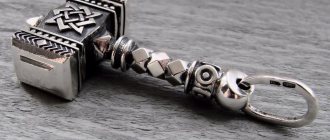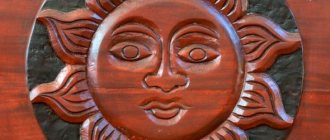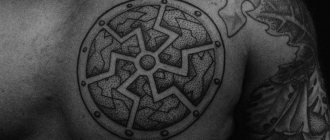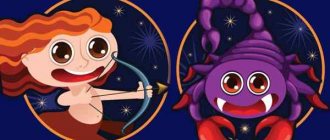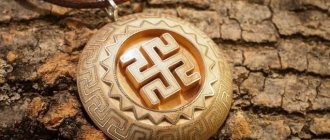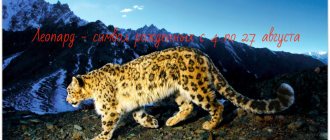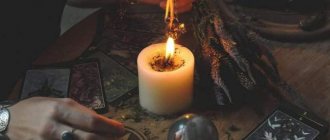There are no primitive peoples, eras, cultures or religions; each has its own wisdom and beauty. We ourselves are primitive in our own laziness and ignorance, in our reluctance to know anything. Maria Semenova In Slavic mythology Svarog
- God of fire, blacksmithing and family hearth.
According to some researchers, the name of the deity comes from the Slavic words “svara” and “svar”
, which means punisher, punisher. In this theory, the image of God Svarog appears to be that he gave law and order to the mortal world and taught them to live, separating them from animals. All those who neglected his commandments were punished by the divine punishment of Svarog.
Svarog created the earth and brought knowledge and laws to people. He found the magic stone Alatyr and uttered the magic words. The stone grew and became huge, Svarog plowed the ocean with it and the first land appeared. He also used stone for other purposes. Inflicting powerful blows on him, Svarog extracted many sparks, from which new gods appeared.
Svarog taught people to cook (create) cottage cheese and cheese from milk, which were once considered sacred food, a gift from the gods. God also created Blue Svarga - a country in the heavens where our glorious ancestors live. Bright stars are their shining eyes, with which grandfathers and great-grandfathers look from heaven at our earthly affairs. Bungle
still means to create miraculously. You can cook and “jaw” only with the help of fire and water (“var” – Sanskrit, water). In addition, Svarog threw a plow and a yoke from the sky to the ground in order to cultivate the land; a battle ax to protect this land from enemies, and a bowl for preparing a sacred drink in it.
Who is Svarog
This character is known as the blacksmith god among the Slavs and the lord of heavenly fire. His name often sounds in the same breath as Perun, Veles and other celestials. However, this hero did not find a place in the pantheon of Prince Vladimir, where the idols of the most revered deities were collected.
His figure is very ambiguous. On the one hand, it found a place in Russian chronicles and Byzantine chronicles, from which the image was to a certain extent reconstructed. On the other hand, Svarog became a character in legends and theories, where he is called almost the main god-demiurge, the embodiment of the Family itself.
Origin of the name
There is a version that Svarog created and “bungled” the earth’s surface and the first gods. Researcher M. Vasmer derives his name from the common Slavic root “svar”, and the heavenly blacksmith turns out to be very conflicting, capricious, that is, “grumpy”. There is also an opinion that the name of the deity is not Slavic at all, but goes back to an older, common Indo-European root. The word was borrowed in ancient times, long before the new era, through contacts of our ancestors with distantly related Indo-Iranian nomads who once inhabited the northern Black Sea region.
Indeed, Slavic mythology is typically Indo-European in its characteristics, so scientists manage to recreate parallels not only in the images and functions of deities, but also the etymology of their names through linguistic analysis. In ancient Indian myths there is an image of Svarga - this is one of the seven heavenly worlds, the paradise of the thunderer Indra. The root svarga itself in Sanskrit and other languages of the Indo-Aryan group means “sky” and related concepts. And this is already very close to the functions of Svarog as the ruler of heavenly fire, giving birth to earthly fire, which also burns in the forge.
Thus, regarding the origin of the name, we understand the following:
- it definitely goes back to an ancient Proto-Indo-European root;
- it took shape in Slavic speech in the process of linguistic evolution, but it could also have been directly borrowed from its neighbors - as happened with Khors and Simargl;
- “fiery” etymology of the name of the Slavic god who guards the heavenly fire.
Legends and myths
Myths, legends and tales about Svarog can be divided into three main plots - cosmogony (his creation of matter and gods), the ordering of chronology and the gift of skills and crafts to people.
The Heavenly Blacksmith was the first hypostasis and embodiment of the demiurge and forefather of Rod. Svarog found the magic stone Alatyr - the same one that is described in fairy tales and lies on the island of Buyan near an oak tree, which in its essence is nothing more than the archetypal image of the World Tree. Once upon a time there was no land - only the sea, into which Alatyr was thrown by Svarog. It foamed, and thus the earth’s firmament was created. Then, by hitting this stone with a hammer, Svarozhichi was created. The legend names among them Perun, Stribog, Semargl and Dazhbog.
Kolo, or circles, of Svarog are another contribution of the keeper of the divine fire to the treasury of human knowledge. There are two of them, big and small. These are circles of earthly and heavenly time, which later served as the basis for the calendar, fortune-telling of the Magi and astrology.
Also, the giver of fire gave people practical knowledge and crafts, primarily blacksmithing and skills in working with metals. Thanks to him, people know such tools and objects as the yoke, plow, sword and battle ax. However, the god-blacksmith also knew a lot about agriculture - according to legend, he also figured out how to make cheese and cottage cheese from milk.
Svarog - patron of blacksmiths
One of the most famous aspects attributed to one of the highest gods of the Slavs is his blacksmithing. Any forge in itself is the temple of Svarog, and the anvil and hammer are symbols of Svarog. According to legends that have come down to us both in the form of fairy tales and in the form of references in teachings against paganism, Svarog taught people to forge metal and create tools. To do this, he gave people ticks that fell from the sky.
Some researchers of ancient folklore attribute this legend to the discovery by people of a meteorite that fell from the sky, which consisted of iron and served as the first source of metal for the ancient Slavs, but this is only an assumption. It is worth noting that Svarozhich was the name given to both fire and a shooting star in the night sky. The falling Svarozhich stars and the metal pincers that fell from heaven, given to people by Svarog, can quite plausibly explain the origin of this myth.
Who is patronized?
In the pagan pantheon of any people, each deity or spirit has its own specialization. Warriors and princes made sacrifices to Perun, the farmer honored Veles, and women asked Mokosha for a successful outcome of the birth.
Svarog helps blacksmiths, artisans and all those who do manual labor. But there is also a broader understanding of him as the patron god of hardworking and creative people in general, who work hard and create the world. According to modern pagan Rodnovers, he also patronizes those who have chosen the path of professional sports, especially in the field of weightlifting and martial arts. A man of action, active, responsible and devoted to his calling will find support from this deity.
Svarog - heavenly blacksmith and judge of the Gods
He is the father of the Svarozhich Gods.
The Slavs know that Svarog loves people who are hardworking, strong and true to their word. People turn to Svarog to gain wealth and success in work. God the Blacksmith will help those who are ready to work hard themselves! The men ask Svarog for good health. Women turn to him to protect their children from illness. If they want to find the right solution, they ask for a hint from Svarog, a wise judge in disputes. View the selection → Svarog is one of the most revered Slavic Gods. We find mention of it in ancient chronicles. The language itself preserves the memory of God Svarog, as a skilled blacksmith, the patron of craftsmen - we even now say “bungle” in the sense of “to do, to create something.” Svarog is also revered as the patron saint of families, because he himself is married to Lada Mother and their union is strong and happy. They say that at weddings God Svarog binds people’s destinies into one, and Goddess Lada brings love and understanding to a young family.
Svarog, God of the Slavs.
Let's talk about when people turn to God Svarog today.
Appearance of the deity
Little is known about Svarog - the main sources are “The Tale of Bygone Years” and the translation of the Byzantine chronicle of John Malala, where the Greek author identifies him with the ancient blacksmith god Hephaestus. Therefore, the image is literally restored bit by bit. There is a hypothesis that in the myths and pagan beliefs of the ancient Slavs, Svarog was rather the personified and personified element of fire rather than an anthropomorphic deity like Perun or Dazhbog. But these days it is already difficult to distinguish the truth from beautiful fiction.
No idols of the deity have survived. In modern neo-paganism, his idol has its own symbolism and is almost always depicted with its main attribute - a hammer.
Origin story
Svarog was included in the divine pantheon of the Slavs along with Veles and Perun. This is the god of fire and the family hearth, who patronized blacksmithing. Svarog is the master god, he had the honor of creating the sacred fire. Some believe that Svarog is the father of Dazhdbog, the god of the sky, others claim that he is the patron of the sun. The character possessed incommensurable strength and was famous for his military merits.
Veles
In Slovakia it is known as Rarog, in Etrusia as Velhans. The Finns called him Ilmarinen, and the Romans called him Vulcan. Translated from Sanskrit, the meaning of the deity’s name is deciphered as “light” or “sky,” and the suffix that ends the name allows one to see the god as a blacksmith.
Bringing knowledge to people, the mythological character invented blacksmith tools and taught people to work with copper and iron. The Slavs owe him the first laws promoting monogamy. A descendant of the ancient gods Cityvrat and Krta, Svarog became the ruler of light and ether, and also controlled fire. The role of the deity in the pantheon is comparable to the place of Zeus on Olympus. Svarog works with his hands, creating material things and refusing to use magical abilities.
Perun
The Slavs believed that in places where Svarog was worshiped, there should be metal products and the constant presence of fire was necessary. Therefore, forges became suitable locations for chanting the god who led the Slavs into the Iron Age.
The idols of Svarog looked inconspicuous. These were large rough stones with the symbol of fire on them.
Attributes of Svarog
The main item belonging to the deity is the hammer. According to legend, they struck the Alatyr stone. The sparks struck during this gave birth to the Svarozhich gods - and did not go out, but may well fall into a person, giving birth to a creative gift in him, as the belief says.
Since ancient times, the Slavs were afraid of sorcerers and wise men, attributing to them the ability to become werewolves and turn into wolves. Svarog also has this skill - the blacksmith god can come to the human world in the form of a fiery boar.
There is an opinion that the bird of paradise Alkonost serves him, being a messenger, and delivers orders to both people and gods. However, this plot arose quite late, because the image of Alkonost was borrowed in Rus' from Greek myths through the Bulgarian scribes. This happened no earlier than the 12th century, that is, after the adoption of Christianity.
How and from what to make a talisman
After choosing a talisman, a logical question arises: buy or make it yourself.
The easiest option is to order or buy a ready-made amulet from a master. It is not recommended to make a talisman yourself.
A blood relative is best suited for this.
When making a talisman, you need to follow a number of rules:
- Start work during the waxing moon.
- Thoughts should be pure and positive. While doing this, think about the person for whom you are making the amulet.
- There should be no one in the room, only you.
- Light a candle to clear away negative energy.
- Be careful when applying the pattern - everything should be clear, without any inaccuracies in the design.
- There should be no extraneous sounds in the room.
- To work you will need any natural material (leather, wood, clay).
- If you embroider, try not to use scissors and hoops; start stitching from the middle of the fabric, and there should be no tangled threads on the back side.
- Try to make the amulet in one day. In this case, his magical power will increase.
- If the work is not finished, it is removed so that other people cannot see.
- Friday and the first half of Sunday are not suitable for making the Star of Rus' amulet.
IMPORTANT! It is better not to use silver and gold. Copper is well suited for making a ring, for example.
If you know how to work with wood, you can make an amulet yourself.
You may be interested in: Bear claw amulet: Meaning, what it will help with, who it’s suitable for
To do this, a small cut of wood is taken, sanded, then a mark is applied, and everything is varnished. A talisman made in this way is worn as a pendant.
The Star of Rus' can be drawn on thick cardboard, framed as a picture and hung on the wall in the place where all family members spend the most time.
You can even take a photo of this symbol. However, his power will not disappear.
Deity symbols
The symbolism of the blacksmith god is characterized by an abundance of solar signs, present in a wide variety of combinations. This is due to its function as the guardian of both earthly and heavenly fire - namely, the Sun is its source, supporting movement and life in the material world.
Konegon
It is a solar symbol, that is, one of the variants of the swastika or Kolovrat. But in this case, the basis of the sign is not a dot in the center, but a square. The horse seems to be assembled from several figures, each of which most closely resembles an ordinary plow. Here you can see the symbolism of agricultural labor in the form of a tool given to people, as well as the infinity of movement that creatively transforms the world around us.
Svarog Square
Also called a star, forge or cross. You can easily find the features of all these geometric shapes in it. The cross is formed by two acute-angled ellipses enclosed in a square and intertwined with it. This symbol embodies the strength and power of human creativity.
Svarozhich
At the base is a large swastika, at its ends there are four small ones, all this merges into a single whole and looks like a harmonious figure. The symbolism is easy to guess - this is Svarog himself and his four sons. As a talisman, this sign is designed to protect from evil, help rid the psyche of negativity, find oneself, set goals and achieve them.
Svarga
Here we see the merging of two swastikas, where the larger one absorbs the smaller one, projecting infinite space onto a single plane. The essence of Svarga is the transformation of the human personality, development through overcoming oneself, abandoning the past and previous habits.
Hammer
Perhaps the main attribute and distinctive feature of Svarog is that the deity is most often depicted with this hammer, used as a blacksmith’s tool. He embodies the strength, security and composure necessary in difficult life situations.
Symbolism of the Star of Rus' “Svarog”
The Star of Lada and the Square of Svarog are often confused; they believe that they are one and the same.
In fact, these are different symbols. Outwardly, they are similar - an eight-pointed star, in the center of which there is a square and 2 intertwining ovals.
IMPORTANT! The Star of Lada has rounded ends of the ovals, and the Square of Svarog has pointed ends.
The eight-pointed star shows the unity of the three worlds
- Rule - the abode of the Gods;
- Reveal - the world of people;
- Navi is a haven of dead souls.
You may be interested in: The meaning of the Rod symbol, what it helps with and how to use it
Only with the unity of these worlds is the balance necessary for the existence of life on earth possible.
REFERENCE! The eight-pointed star also shows the unity of mind, body and inner spirit, and is also a symbol of time and its movement.
The intertwining ovals symbolize the harmony of the feminine and masculine principles.
The square enclosed at the base speaks of the fertility of the earth.
But in the Seal of Svarog, the square symbolizes the forge (Svarog is the blacksmith god). The lines extending beyond the base of the square mean human virtues:
- Freedom;
- Faith;
- Virtue;
- Honor.
In addition, they indicate the natural elements (earth, water, fire, air) and the 4 cardinal directions.
And this explains the fact that Lada the Mother of God helps people, since she sees everything.
REFERENCE! The symbol of the Star of Rus' (Svarog Square) is male, and the Star of Lada is female.
God's amulet - Star of Svarog
This symbol has become one of the most popular images in modern neo-paganism and Rodnoverie. Now it is familiar even to people far from this spiritual tradition or subculture. The Star of Svarog is applied in the form of a tattoo and is depicted on the flags of some political movements and the covers of releases issued by thematic musical groups. Therefore, we will consider this sign and amulet separately.
What does it look like
On the one hand, due to some external features, people sometimes put the star of Svarog on a par with such solar symbols as various forms of swastikas and Kolovrat. Indeed, there is a certain similarity, but the essence of the sign is completely different. The star is also called the Svarog square, because this figure is the basis here. A cross of two elongated ellipses is inscribed in it. The key thing in the geometry of the symbol is not the dynamics of circular motion, as with classical solar symbols, but the plexus.
Who is it suitable for?
Many people see the star as a Slavic pagan symbol in general, which is why a talisman with its image is often endowed with rather general or universal functions. But in fact, the star is intended for something else - she is, first of all, not a protector, but an assistant, inspirer and motivator.
This talisman is designed to awaken hidden inner strengths in the wearer for self-development and the realization of talents. However, it may also protect against interference and obstacles on the way to achieving the goal.
The amulet is most useful for people engaged in hard physical labor associated with creativity, craft or professional sports, especially in the field of martial arts. For this reason, the star is more in demand among men than among women. It is suitable for brewers and producers of other alcoholic beverages - according to legend, Svarog also taught this skill to people.
The power of the amulet
A star can be a talisman in different material forms, but its power, as is generally believed, will differ. God with a hammer in his hands patronizes creative people, so making an amulet yourself is preferable to buying it. It will be good as a gift to students or a reward for merit.
A star can decorate a room - but it must be a place for work or creativity, that is, a workshop, workshop or office of a manufacturing company, otherwise the amulet loses its power. The symbol also looks good on clothes, especially work clothes. Many people apply it as a tattoo, but it is recommended to take it seriously - after all, by depicting a design on the body, sometimes you can radically change your life.
The famous boxer Alexander Povetkin seems to be ready for such changes. Being a follower of the spiritual traditions of the ancient Slavs, he got a tattoo of the star of Svarog before a fight with a very serious opponent and eventually won in the ring.
How to use and wear
When choosing a talisman, pay attention not only to its meaning, but also to how you will wear it.
You may be interested in: The meaning of the Slavic symbol fern flower (Perunov color)
For personal use, it is better to consider jewelry or tattoo.
Men can wear pendants, rings, pendants, belts, leather bracelets, women can wear pendants, earrings or rings.
Of course, all these items must have the sign of the Star of Rus' (Svarog Square). In this case, it is advisable to wear the jewelry closer to the heart.
Tattoo
Tattooing is an option that does not require much hassle (no activation or constant cleaning required).
It is best to apply the image closer to the heart so that the amulet connects as strongly as possible with the energy of the owner.
The shoulders and back are also ideal for tattooing. In any case, it is better to hide the image on the body from prying eyes so that people with unclean thoughts cannot cause harm.
Embroidery
Another interesting and magical option for using the Star of Svarog symbol is embroidery.
It is interesting that the symbols of not all amulets can be applied to clothing.
But the Star of Rus' is a happy exception to the rule. The ancient Slavs often embroidered this sign on the shoulders, collar and hem of their shirts.
Nowadays, you can embroider a protective symbol on a towel, curtains, or bed linen.
Paintings embroidered with beads or cross stitch also look beautiful and do not lose their protective potential.
Commandments of the deity
This concept is well known to us from the teachings of the Abrahamic religions. However, the commandments are found not only among followers of monotheism, but also among adherents of pagan beliefs.
Those who worship Svarog formulate them as follows:
- Respect the human person, children should honor their parents, husband and wife should preserve harmony in family life.
- Maintain marital fidelity.
- Avoid evil, follow the path of truth, honor the earthly and heavenly race.
- Celebrate Kupala and the summer solstice, the days of Perun, Mokosh and Dazhbog.
- Honor the elderly and take care of children.
- Living in peace and harmony with other clans and tribes, helping neighbors in difficult times.
- Defend faith, home and native land, not sparing life.
- Respect freedom of conscience and religion.
- Live in union and harmony with nature.
- Do not offer blood sacrifices to the gods.
- Protect temples and sanctuaries.
- Do not eat blood.
- Raise children for a righteous life.
- Do not assert yourself at the expense of the weak, but gain glory in the fight against enemies.
- Don't bear false witness.
- Do good for the glory of the Family and ancestors.
- To bring reward to people according to their deeds.
- To know the hitherto unknown.
- Do not kill your neighbor, but also do not spare enemies who attack your native land.
- Do not accept rewards for healing and other manifestations of the divine gift.
Commandments
God Svarog created the earth, taught people to work, and gave a plow so that people could live in abundance. Taught blacksmithing. Gave me fire.
The ancient Slavs honored their creators and lived by certain commandments, which were later rewritten by the Christian Church. From the commandments preserved to this day, it is clear that the main values of our family were: family, honesty and hard work. The main task of everyone is to protect the land and their family.
Polygamy, laziness and greed were not honored. The main values were considered to be spiritual values, kindness, helping others and mutual respect.
Sciences for Svarog
In the Slavic tradition, learning is understood as magical practice and conspiracies, accompanied by tying a special knot. When it is ready, it turns into a talisman and is designed to help the owner in solving a particular problem.
The sciences addressed to Svarog help in the following:
- elimination and removal of spells and slander;
- ridding thoughts of negativity;
- cleansing the body, soul and surrounding space;
- starting a family or strengthening personal relationships;
- setting the mind to think correctly.
Svarog - Slavic God of family unions
When we talk about the Slavic Gods of the Family, first everyone remembers Lada-Mother, but they don’t always remember about Svarog. However, this God also protects the Slavic family - judge for yourself.
Do you need wealth in the home for family happiness? Definitely needed! A decent job for the head of the family, a job with which you can glorify your Family? Definitely necessary! Especially if the men in the family did not follow the military path, but became skilled craftsmen and live by this labor. The transfer of knowledge from father to son and responsible performance of parental responsibilities are also necessary for a strong family. And here we remember God Svarog! People turn to Lada-Mother more for love and warmth between husband and wife. They turn to Svarog for advice when they want to do everything honorably, not to forget about any important matter for the family, not to offend anyone, to judge quarrels between children fairly.
We also know the special amulet of God Svarog, which sons wear in order to gain the protection of their father’s Family. The father gives his son such a talisman to convey his wisdom and teach him to live wisely. This sign is called Svarozhich. It is dedicated not only to Svarog himself, but also to his children - the Svarozhich Gods.
Holidays in honor of the deity
Little information about the ancient cult of the blacksmith god has reached our time. Therefore, it is unclear exactly what memorable days our distant ancestors dedicated to him, and today, at pagan festivals, people pay homage along with other gods without reference to calendar dates. However, among modern Rodnovers there is an established custom of celebrating Svarog Day on November 14. During the celebration, it is customary to light fires and wash with clean water, paying tribute to the fiery nature of the deity.
The image of Svarog in culture and creativity
The figure of the heavenly blacksmith inspires many writers and artists these days. The Internet is full of graphics and drawings depicting the deity. Most often you can see a physically strong and strong man of middle or old age, armed with a hammer, with strong-willed facial features. He is shown as a creator or artisan, often surrounded by idols in the harsh northern landscape.
Authors working in the fantasy literary genre create works on pagan themes. Thus, the writer Alexander Bushkov wrote a whole book cycle named after Svarog, the novel “Alien Sails” is especially popular. There are rumors about a possible film adaptation of Bushkov's works. But so far, Svarog remains the hero only of documentaries and popular science films or videos on YouTube.
When should you turn to God Svarog?
When you ask for help in your work: Svarog will help if you yourself are ready to work. You probably shouldn’t ask God Svarog for sudden acquisition of wealth. But if you want to become successful in your business, gain wealth through your work, feel free to contact him. If you want good relationships with your family, a strong family, turn to God Svarog. In this case, be prepared to see your shortcomings. If you ask Svarog for help in strengthening your family, all the obligations that you have undertaken to your family must certainly be fulfilled. Turn to God Svarog for a fair trial, to resolve issues in your favor, if you know that your cause is just. And may the Native Gods always be with you!
0
Related:
- Pagan gods of the Sami
- Spozhinki Dozhinki is a holiday for the common good
- How to correctly address the Slavic Gods
- The Slavic Gods of Spring will descend to earth from March 20
- Goddess Maya - Weaver of the Web of Life
New articles
- How to correctly address the Slavic Gods
Deities associated with Svarog
First of all, the forefather Rod, whose hypostasis Svarog is considered, is associated with the blacksmith god. He himself is the father of four deities born with a hammer blow - Perun, Dazhbog, Stribog, Semargl. There is also an alternative version of the genealogy, where the figure of his wife, the goddess Lada, appears. The couple had Perun, his sisters were Lelya, Zhiva and Morena, who are responsible for spring, summer and winter, respectively, and his brothers were Lel and Polel, who, in turn, patronized passionate love and mature family relationships.
Slavic God Svarog - a fair judge
When God Rod created the world and retired from business, he left God Svarog as the main judge between the Gods. Do you know that the Slavic Gods have different characters and are not simple? Every now and then they argue among themselves, they cannot decide who is right and what is the right thing to do. In this case, they go to God Svarog for advice, and he finds the right solution for everyone. They say that there were cases when people came to Svarog for trial. We know this fairy tale about Velush, a woman who lost her home and husband:
“Yes, it was me who ended up in the Heavenly Forge!”
- Velusha guessed. And the blacksmith is Svarog himself, Heavenly Father! She took a closer look: “Yes, that’s definitely him!” Here is the magic anvil, Alatyr-stone. And how the sparks fly! Yes, these are God’s sparks that fly to the earth and fall into people’s hearts. These are miracles, everything was explained by the sorcerer! Who are the guys then? Red - exactly Svarozhich, the god of Fire Semargl, and then who blows the furs? Not otherwise Stribog-wind! “Velusha didn’t even notice how she started talking to herself. The guy at the forge turned at her voice:- Father, we have a guest.
Svarog put down the hammer, wiped the sweat from his forehead with his palm, took off the ribbon holding his hair, nodded to his son:
- Give me some surya. He rushed to the shelf, took out a jug, and handed it to his father.
-Oh, it’s a shame that Veles and I got a little carried away yesterday...
He turned his eyes to Velusha:
- What happened, granddaughter? Tell me, honey. Velusha blinked, shook herself and started babbling:
- Svarog-father, she returned home, her husband is gone, she’s not at home, no one knows. And Chur says, Svarog knows everything, he gave me the ball, Chur’s sister also says, we need to see Svarog... She said something else, repeated, repeated again. But Svarog was already thinking his way.
- So you say, Chur gave me a talisman, advised me to contact me, and Baba Yaga transported me here? — Svarog asked incredulously, looking at Velusha. “A woman is like a woman. How can it be that both of them sent her to me? Well, I’ll have to get busy,” he thought grumpily. Svarog was not in the best mood in the morning. We used too much surya yesterday with Veles. My thoughts were confused. Then he shook his head, as if dismissing all doubts, took Velusha by the hand and led him into the upper room. The sons Semargl and Stribog entered next. Svarog took out what looked like a tablecloth from the chest and spread it on the table:
- Now let’s see where this house is!
Velusha took a closer look and gasped. Everything was marked on this tablecloth: every house in their village and every tree in the forest. Yes, not just indicated, but everything as real! And she took a closer look, couldn’t resist and screamed:
- Fathers of light! So everyone is there alive. There are women milling about at the well, apparently discussing me, and there are cows heading towards the forest to graze!
“Well,” Svarog asks her. - So where is your home? Velusha looked and pointed her finger at the clearing:
- Here I was... - You’re not mistaken? Look good! - Svarog shouted. And he thinks: “What is this happening! Without my knowledge, without my permission, houses began to disappear to God knows where! Well, someone will get it for nuts!” And Velusche calmly says:
“Now they’ll take you out, rest, have a snack, and I’ll ask around to someone about where the house might have been hit.”
Of course, not everyone ends up in judgment before God Svarog himself, but many turn to him. In the old days, in our North there were even special conspiracies against Svarog, so they were called “conspiracies for a fair trial.” They read such a conspiracy, for example, on a special knot - Nauz. They tied it for a man who knows that his cause is just and wants the court to make a decision in his favor. Such a knot will also come in handy in other situations where you need a fair decision that depends on other people.
